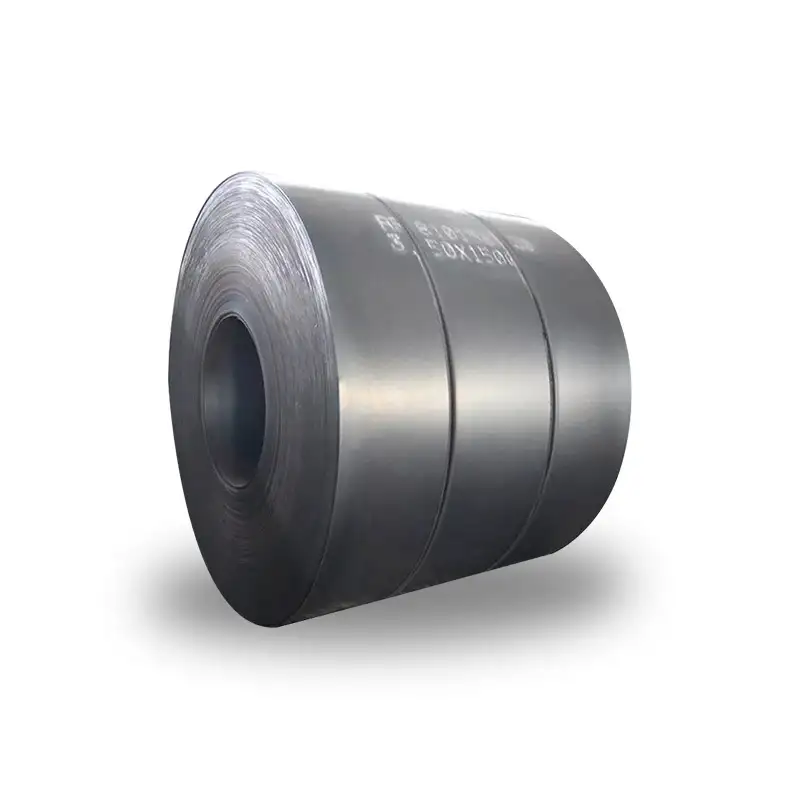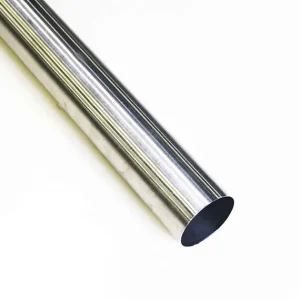A572 (commonly A572 Grade 50) and EN S355JR are comparable high-strength, low-alloy structural steels frequently supplied in coil form for fabrication and plate conversion. For most structural and civil applications that require a minimum yield near 345–355 MPa, either specification is acceptable provided you confirm the purchaser’s required impact, chemistry, and delivery conditions. MWAlloys supplies A572 / S355JR carbon steel coils from China with 100% factory pricing and ready stock for quick shipment to global projects.
What is A572 / S355JR carbon steel coil?
A572 (specifically A572/A572M Grade 50 in ASTM nomenclature) and S355JR (EN 10025-2) are high-strength, low-alloy structural steels widely used for beams, channels, plates and coil-converted plate. When supplied in coil form, the steel is typically hot-rolled strip (HRC) that can be slit, cut-to-length, or processed into plate. The two standards come from different standards bodies (ASTM for A572, European Committee for EN), but their mechanical requirements — particularly minimum yield strength around 345–355 MPa for the commonly used grades — make them practical equivalents for many designers, subject to chemistry and impact requirements.
Key differences and equivalence: ASTM A572 vs EN S355JR
-
Standards origin: ASTM A572 is a U.S. standard covering high-strength low-alloy columbium-vanadium steels in several grades (42, 50, 55, 60, 65). EN 10025-2 covers non-alloy structural steels such as S355JR, S355J0, S355J2 and others.
-
Nominal strengths: A572 Grade 50 (ASTM) typically specifies a minimum yield of ~345 MPa (50 ksi), whereas S355JR specifies a minimum yield of 355 MPa (metric designation). Practically, yield and tensile bands overlap and engineers often accept one for the other after review.
-
Chemistry & microalloying: A572 Grade 50 may specify microalloying elements (Nb, V) and has different permitted max C, Mn, Si, P, S limits compared with S355JR. The presence/absence of microalloying and permitted ranges can affect weldability and toughness; always confirm mill certificates (MTRs).
-
Impact/toughness: Suffixes in EN (JR, J0, J2) denote different impact testing regimes. S355JR denotes longitudinal Charpy V-notch at room temperature (JR). ASTM A572 may not require the same Charpy level unless specified in the purchase order.
Practical takeaway: For most structural coil-to-plate conversions the two grades are interchangeable on strength alone, but chemistry, toughness at low temperature, and purchaser required tests determine acceptance.
Typical chemical composition
Note: the table below shows typical maximums or ranges quoted for A572 Grade 50 and S355JR from commonly used mill tables. Final acceptance depends on MTRs from the supplying mill.
| Element | A572 Grade 50 (typical, wt%) | S355JR (EN 10025-2 typical, wt%) |
|---|---|---|
| Carbon (C) | ≤ 0.23 (max) | ≤ 0.24 (max) |
| Silicon (Si) | ≤ 0.40 | ≤ 0.55 |
| Manganese (Mn) | ≤ 1.35 (min/typ) | ≤ 1.60 (typ max) |
| Phosphorus (P) | ≤ 0.04 | ≤ 0.035 |
| Sulfur (S) | ≤ 0.05 | ≤ 0.035 |
| Copper (Cu) | — (trace) | ≤ 0.55 |
| Niobium/Vanadium/Ti | May be present (microalloying) per A572 spec. |
(Source: representative mill tables and standards summaries — use MTR for contract acceptance.)
Material properties
| Property | A572 Grade 50 (typical minimum) | S355JR (EN typical minimum) |
|---|---|---|
| Minimum yield strength (Rp0.2 / ReH) | 345 MPa (50 ksi) | 355 MPa (min) (S355 designation) |
| Tensile strength (Rm) | 450 MPa (typ min) | 470–630 MPa typical range (depends on thickness) |
| Elongation (%) | 18% (in 8 in) typical for Grade 50 | Varies by thickness; EN tables specify minimum elongation values. |
| Impact (Charpy) | Not universally specified in ASTM A572 unless called out; purchaser may require. | JR = 27 J at +20 °C (typical for S355JR). |
A572 / S355JR Carbon Steel Coil specifications
This table captures common commercial coil specs used by mills and traders. Always verify with the mill’s technical datasheet.
| Parameter | Typical Values / Range |
|---|---|
| Product form | Hot Rolled Coil (HRC), pickled & oiled, or coated as ordered. |
| Thickness (strip) | 2.5 mm to 15.9 mm typically for coil-for-conversion; thinner values possible after rolling. |
| Width | 600 mm to 2400 mm typical (common widths: 1000, 1250, 1500, 2000 mm). |
| Inner coil ID | 508 mm (20") or 610 mm (24") typical depending on mill. |
| Outer coil OD | Mill dependent — limited by logistics and handling. |
| Coil weight | 3–30+ metric tonnes (typical factory coil weights 7–25 tonnes). Use coil weight calculator. |
| Surface finish | Hot-rolled dark, pickled & oiled, or coated on request. |
| Tests and documentation | MTR (EN 10204 / 3.1 or 3.2), chemical analysis, tensile, flattening, NDT if specified. |
Coil sizes and weight
Standard coil weight formula (metric):
Weight (kg) = Width (mm) × Thickness (mm) × Length (m) × Density (kg/m³) / 1,000,000
Using steel density ≈ 7,850 kg/m³.
Alternate practical formula for a parent coil (using length derived from rolled coil):
Weight (tonnes) = PIW (pounds/in of width) × Width (in) × 0.00045359237 / 2000 — (industry calculators exist). Use mill coil calculators for accuracy.
Example 1 — simple slab length method:
Given: Width = 1,500 mm; Thickness = 6.0 mm; Length = 1,000 m
Weight (kg) = 1,500 × 6 × 1,000 × 7,850 / 1,000,000 = 70,650 kg → 70.65 tonnes.
Example 2 — typical factory coil:
Coil outer diameter and inner diameter are used with formulas found in coil calculators to derive total length and weight — mills commonly produce coils in the 8–20 tonne range for typical plant handling.
(Tip: request mill-stamped coil weight and MTR for invoicing — calculators are guides only.)
Manufacturing, mill tests and traceability
-
Mill testing: Standard Mill Test Reports (MTRs) per EN 10204 (3.1/3.2) or equivalent must accompany shipments: full chemical analysis, tensile test results and heat number traceability. A572 orders typically require ASTM A572 acceptance tests; EN orders require EN 10025 test regimes.
-
Non-destructive testing: If the user demands UT or magnetic particle tests for critical plate conversions, these must be specified in PO.
-
Heat treatment & processing: Hot rolling followed by controlled cooling; pickling or descaling and oiling optional. For improved toughness, some grades undergo controlled rolling and microalloying additions (Nb/V).
Applications, fabrication and welding notes
-
Applications: Bridges, building frames, cranes, heavy equipment, structural plate, welded assemblies and conversion to fabricated sections.
-
Welding: Both A572 Grade 50 and S355JR are weldable with standard GMAW/MIG, SMAW and FCAW procedures. Preheat and heat input should be controlled when carbon equivalent (CEV) rises. Check mill carbon equivalent if welding thick sections.
-
Forming: Bending and forming are straightforward within recommended bend radii; thinner gauges are more formable. Always consult supplier for recommended bending radii and allowances.
-
Surface prep: For paint systems, pickled & oiled or shot-blasted finishes result in better coating adhesion.
2025 Price (United States, Europe, China)
Price data for flat/coiled structural carbon steel varies daily. The table below summarizes representative spot ranges and reported ex-works or FOB ranges during 2025 sourcing commentary and weekly market reports. These values are indicative and should be confirmed with quotes and INCOTERMS.
| Region | Representative 2025 range (USD / metric tonne) | Notes / data sources |
|---|---|---|
| United States | ~$840 – $975 / t (hot-rolled coil spot ranges in mid-2025). | U.S. mill CSP and spot ranges reported May–Jun 2025. |
| Europe (NW Europe ex-works) | ~€540 – €640 / t (~$625 – $740/t depending on FX) mid-2025. | MEPS & MetalMiner reported ex-works HRC quotes in summer 2025. |
| China (domestic / FOB) | ~$440 – $520 / t (FOB); domestic CNY figures showed ~CNY 3,200–3,600/t (~$440–$495/t) in mid-2025. Supplier listing ranges are wider (lower MOQ offers start ~USD 400–500/t). |
Interpretation & buyer notes: regional price spreads reflect tariffs, freight, and local scrap/iron ore costs. U.S. prices were elevated by tariff and CSP dynamics in early 2025 while China domestic prices remained comparatively lower (but vary by grade and shipment terms). Always request firm mill offers including delivery/incoterm and MTR.
How MWAlloys positions this product
MWAlloys supplies A572 / S355JR carbon steel coils from reliable Chinese mills with the following guarantees for procurement teams and fabricators:
-
Factory price (100%): direct factory pricing without trading margins. We publish ex-works and FOB quotes on request and confirm via mill invoice with heat numbers.
-
Fast stock & delivery: MWAlloys maintains bonded/allocated inventory and can arrange export packages (coil lashings, skids) for fast shipment — typical lead times from stock are 7–21 days depending on destination.
-
Quality & traceability: Every coil ships with MTR (EN 10204 3.1) or equivalent; clients can request additional third-party inspection prior to shipment.
-
Custom processing: slitting, cut-to-length, edge conditioning and short lead times for small/large orders.
-
Sourcing network: partnerships with mills producing A572 / S355JR grades, ensuring material conforms to ASTM A572/A572M and EN 10025-2 requirements.
FAQs
-
Q: Are A572 Grade 50 and S355JR interchangeable?
A: Often yes for strength, but you must check chemistry and toughness acceptance (especially if low-temperature impact is critical). Provide MTRs to confirm. -
Q: What thicknesses can be supplied in coil form?
A: Typical coil-for-conversion strip runs ~2.5–16 mm; consult the mill for specific thickness/width matrix. -
Q: How is coil weight calculated?
A: Use the width × thickness × length × density (7,850 kg/m³) formula or an online coil calculator; mills provide stamped coil weight as final. -
Q: Which certificate comes with MWAlloys shipments?
A: Standard MTR (EN 10204 3.1 or equivalent). Third-party inspection can be arranged. -
Q: What is the typical delivery time from stock?
A: If in allocated stock, 7–21 days depending on packing and destination. For newly rolled orders, lead times follow the mill schedule. (MWAlloys maintains fast stock options.) -
Q: How to control welding preheat for these steels?
A: Check carbon equivalent (CEV) from the MTR; for higher CEV use preheat/controlled heat input. Consult your welding procedure spec (WPS). -
Q: Can MWAlloys slit coils to custom widths?
A: Yes. slitting and edge conditioning are standard processing services on request. -
Q: Are coated versions (galvanized) available?
A: Yes; hot-dip galvanizing or pre-galvanized coil options require prior arrangement and carry cost/time premiums. -
Q: How do tariffs and incoterms affect delivered price?
A: Significantly — U.S. tariff policy and local duties change delivered costs; always quote with explicit INCOTERM and commodity code. -
Q: What steps should a buyer take before ordering?
A: Specify grade, thickness, width, surface finish, impact requirements (if any), MTR class, and delivery incoterm. Request sample MTRs and shipping plan from supplier.
Procurement checklist
-
Confirm exact standard (ASTM A572/A572M or EN 10025-2 S355JR) and grade.
-
Demand MTR (EN 10204 3.1/3.2).
-
Specify surface condition (HR dark / pickled & oiled / coated).
-
Confirm processing needs (slit/CTL).
-
Lock INCOTERM and freight plan.
-
Ask for third-party inspection for large orders.
Concluding notes
A572 Grade 50 and S355JR in coil form are mature, widely available structural steels. For global buyers the decision usually hinges on specified standard acceptance, required toughness/chemical limits, and the best landed price given tariffs and freight. MWAlloys can provide factory direct pricing, rapid stock shipments from China, sample MTRs and customized processing. For urgent quotations provide grade, required thickness/width, quantity, desired finish and delivery port. Market prices move; get a firm mill offer before committing.





